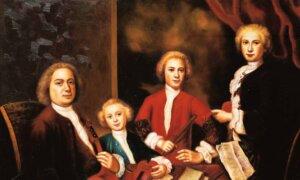“When in doubt, cite Grout,” my mother said. She was referring to Donald Jay Grout’s “A History of Western Music.” First published by W.W. Norton in 1960, it has gone through 10 editions and is considered the definitive single-volume book on the subject.
In the ninth edition, the editors decided to be more culturally sensitive: After “of all time,” they added “in the Western tradition.”

Nitpicking aside, many regard Bach as the greatest composer who ever lived. He was also one of the most prolific. The Bach-Werke-Verzeichnis, or Bach Works Catalogue (BWV), currently ascribes 1,176 pieces of music to him (the most recent 50 of which were only added in our century).
10. Toccata and Fugue in D minor (BWV 565)
This is probably the most recognizable piece of any that Bach wrote, which is mostly due to its association with Halloween. The “Toccata and Fugue in D Minor” displays Bach’s virtuoso organ skills, the instrument for which he was most famous in his lifetime. It begins with fast arpeggios in a free style, then transitions to the more structured Fugue where the main theme is overlapped and repeated in different melodies.9. ‘Air on the G String’ (BWV 1068)

8. ‘Coffee Cantata’ (BWV 211)

Bach’s most celebrated secular cantata is probably the quirkiest of his works. It is the closest thing to an opera that he ever wrote. The plot revolves around a father’s concern with his daughter’s caffeine addiction. Coffeehouses were popular around Europe at this time, so the theme would have resonated with audiences.
You bad child, you wild girl! Oh! If only I could have my way: get rid of coffee!
After assuring her father that she would dry up like a “piece of roast goat” if she couldn’t drink coffee three times a day, she bursts into song, proclaiming that the beverage is “lovelier than a thousand kisses.” The aria is virtuosic, incorporating a minuet and trio sonata involving a flute playing an independent melody equal to the soprano.7. Cello Suite No. 1 in G major (BWV 1007)
The first of Bach’s six cello suites is another recognizable piece. It is structured as a prelude, followed by a sequence of dance movements, displaying his mastery of polyphony. Like “Air on the G String,” the composition is serene, with a deceptive simplicity that disguises its complexity.6. ‘Goldberg Variations’ (BWV 988)

5. ‘St. Matthew Passion’ (BWV 244)
More than 200 of Bach’s cantatas survive today, though at least a hundred more are thought to have been lost. The greatest of these, the “St. Matthew Passion,” is a testament to his devout Lutheran faith. It is a massive work for two choirs and two choruses. Bach employed a variety of musical techniques to narrate the story of Jesus’s last days, like descending chromatic lines and key shifts to represent emotional contrast at the points of crucifixion and burial.4. ‘Brandenburg Concertos’ (BWV 1046–1051)
His “Brandenburg Concertos” are the height of Baroque orchestral composition. Bach made innovative use of instrumentation in these works, like including a trumpet in the second concerto. This was an unusual move for chamber music at the time, and there is some uncertainty as to exactly what kind of trumpet Bach wrote the part for. In this second concerto, he also creates a striking contrast by placing the intimate recorder alongside the oboe and violin.3. Mass in B Minor (BWV 232)
One of Bach’s last works, the Mass in B Minor is a rich tapestry of musical counterpoint and spiritual depth, compiled from earlier compositions. Structured in four parts, it ranges in mood from the festive orchestration of the “Gloria” to the introspection of the “Agnes Dei.” Never performed in Bach’s lifetime, it is now standard in the repertoire of choirs worldwide.2. ‘Well-Tempered Clavier’ (BWV 846–893)
A “clavier” is a general term for a keyboard instrument. Today, most performances are played on a piano, as is the case with Canadian pianist Glenn Gould’s celebrated recordings. In Bach’s day, though, it would have been commonly played on a harpsichord. Methods of tuning keyboard instruments had recently evolved, allowing Bach to compose this two-volume work of preludes and fugues in every major and minor key. This work is so central to keyboard music that it is often called the “Pianists’ Old Testament,” used by advanced students as a comprehensive guide to harmony and technique.1. ‘The Art of Fugue’ (BWV 1080)

For most of Bach’s life, he composed to meet the demands of the moment, churning out new works on a weekly basis. In his final decade, though, he gave this up and concentrated all his energy on producing half a dozen towering masterpieces. These include the Mass in B minor and the “Well-Tempered Clavier.”
It also includes his final, greatest work, “The Art of Fugue.” Its final section, “Contrapunctus XIV,” is incomplete, suggesting that he may have died while writing it.
Published after Bach’s death by his son, “The Art of Fugue” is one of the central works of Western music. In it, Bach developed his ideas on counterpoint to their limit. The work begins with a deceptively simple D-minor theme, which Bach then masterfully transformed in a variety of ways—inverting, augmenting, altering its rhythm, and ever escalating in complexity.
When Bach died in 1750, his style of composition was long out of fashion. The passing of time has seen him in a different light, though. Fads come and go, but Bach’s music is immortal.







